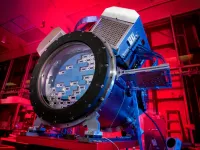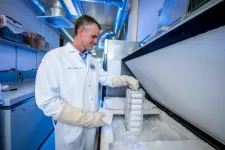(Press-News.org) On scales too small for our eyes to see, the business of life happens through the making of proteins, which impart to our cells both structure and function. Cellular proteins get their marching orders from genetic instructions encoded in DNA, whose sequences are first copied and made into RNA in a multi-step process called transcription.
A research collaboration at Colorado State University specializes in high-resolution fluorescence microscopy and computational modeling to visualize and describe such stuff-of-life processes in exquisite detail, in real time, at the level of single genes. Now, scientists led by postdoctoral researcher Linda Forero-Quintero have, for the first time, observed early RNA transcription dynamics by recording where, when and how RNA polymerase enzymes kick off transcription by binding to a DNA sequence.
The breakthrough technology, detailed in the journal Nature Communications, has countless possible outshoots; these include sharpening understanding of basic biological processes, to unveiling the genetic underpinnings of certain diseases.
"This is the first time someone has looked at RNA polymerase phosphorylation dynamics in a single-copy gene," said Forero, who is a postdoctoral researcher co-advised by Tim Stasevich, Monfort Professor and associate professor in biochemistry, and Brian Munsky, associate professor in chemical and biological engineering. In the past, such early transcription activity could only be visualized using gene arrays, which are artificial structures composed of hundreds of copies of a gene and not commonly found in the cell nucleus.
Stasevich and Munsky lead a collaboration funded by the W.M. Keck Foundation and the National Institute of General Medical Sciences (through two Maximizing Investigators' Research Awards) that's seeking to unveil and quantify real-time genetic expression in living, single cells. Forero, who works in both labs under the auspices of the collaboration, had previously studied proteins and transporters in cell membranes associated with neurological conditions.
Early transcription activity
As described in Nature Communications, Forero et al. designed a method using an established mammalian cell line, engineered fluorescent antibody fragments, and a custom super resolution microscope to capture the process of early transcription in vivid colors: blue, green and red. More specifically, they observed the start of the transcription cycle that happens when the RNA polymerase II (RNAP2) transcription enzyme becomes phosphorylated, or decorated with phosphate groups, on its amino acid tail.
"The interdisciplinary science here is a fantastic blending of new experimental capabilities and a new approach for mechanistic computational modeling of single-cell dynamics, both of which are very novel in their respective fields," said Munsky, who supervises the computational aspects of the collaboration.
In the lab, the researchers loaded their antibody fragments into an established mammalian cell line containing a reporter gene that when transcribed, is lit up by a fluorescently tagged protein. The antibody fragments, which Stasevich helped develop several years ago, are tagged with fluorescent molecules that light up their specific targets in the RNAP2 tail. Using these tagging technologies together, the researchers could distinguish three distinct steps in the transcription cycle, marked by different colors. The images obtained with this system translate into fluorescent intensity fluctuation. The researchers then used those signals to interpret the spatiotemporal organization of RNAP2 phosphorylation throughout the transcription cycle at a single-copy gene.
New information via computational model
Munsky's team led by graduate student William Raymond took Forero and Stasevich's microscopy data and translated it into a computational model based on stochastic differential equations. By fitting this statistical model to reproduce all the experimental results, the computational team then extended their analyses to glean new mechanistic and quantitative information about the different molecules and their states through the transcription process.
For example, they estimated how many individual RNA polymerase molecules collect to form transient clusters in the region of the DNA's promoter, how long these clusters persist, and how, when and where the polymerases distribute themselves along the DNA. They found, for example, that each burst of transcription activity produces a cluster of between five and 40 RNA polymerases to form around the promoter region of the gene, of which 46% eventually succeed to transcribe RNA. They also found that each RNA takes approximately five minutes to be fully transcribed and processed prior to release.
Forero says the technology has far-reaching potential, especially combined with newer technologies like CRISPR, in which specific genes can be singled out and manipulated. Choosing a certain gene of interest, say one implicated in a disease, and applying the CSU researchers' real-time readout of the transcription cycle, could then allow researchers to watch disease processes happening at the activity level of single genes.
"The ability to resolve the spatial and temporal dynamics of the transcription cycle, in one gene, is the most exciting aspect of this work," Forero said.
INFORMATION:
Link to paper: https://www.nature.com/articles/s41467-021-23417-0#citeas
SAN ANTONIO (May 27, 2021) -- One-fifth of babies who inherit a genetic variant located on chromosome 16 will develop autism spectrum disorder (ASD) by age 3. The variant is called 16p11.2 deletion.
Noboru Hiroi, PhD, of The University of Texas Health Science Center at San Antonio (also referred to as UT Health San Antonio), is studying mice that have this deletion. The team, which includes colleagues from Japan, Ireland and the U.S., is harnessing the power of machine learning to understand which vocalizations of the newborn mouse pups are most predictive of social abnormalities one month ...
Nobody likes driving in a blizzard, including autonomous vehicles. To make self-driving cars safer on snowy roads, engineers look at the problem from the car's point of view.
A major challenge for fully autonomous vehicles is navigating bad weather. Snow especially confounds crucial sensor data that helps a vehicle gauge depth, find obstacles and keep on the correct side of the yellow line, assuming it is visible. Averaging more than 200 inches of snow every winter, Michigan's Keweenaw Peninsula is the perfect place to push autonomous vehicle tech to its limits. In two papers presented at SPIE Defense + Commercial Sensing 2021, researchers from Michigan Technological University discuss solutions for snowy driving scenarios that ...
Ionizing radiation is used for treating nearly half of all cancer patients. Radiotherapy works by damaging the DNA of cancer cells, and cells sustaining so much DNA damage that they cannot sufficiently repair it will soon cease to replicate and die. It's an effective strategy overall, and radiotherapy is a common frontline cancer treatment option. Unfortunately, many cancers have subsets of cells that are able to survive initial radiotherapeutic regimens by developing mechanisms that are able to repair the DNA damage. This often results in resistance to further radiation as cancerous growth recurs. But until recently, little was known about exactly what happens in the genomes of cancer cells following radiotherapy.
To probe the traits of post-radiotherapy cancer ...
May 27, 2021 - Patients undergoing total hip arthroplasty (THA) show significant reduction in pain and other symptoms and improvement in walking gait biomechanics. However, those improvements do not lead to increased daily physical activity levels, reports a study in The Journal of Bone & Joint Surgery. The journal is published in the Lippincott portfolio in partnership with Wolters Kluwer.
The findings "present a worrying picture that while patients have the opportunity to be more physically active through improvements in functional capacity, their physical behaviors do not change," according to the new research, led by Jasvir S. Bahl of the University of South Australia, Adelaide, in collaboration with the University of Adelaide, Flinders University, ...
In 29 new scientific papers, the Dark Energy Survey examines the largest-ever maps of galaxy distribution and shapes, extending more than 7 billion light-years across the Universe. The extraordinarily precise analysis, which includes data from the survey's first three years, contributes to the most powerful test of the current best model of the Universe, the standard cosmological model. However, hints remain from earlier DES data and other experiments that matter in the Universe today is a few percent less clumpy than predicted.
New results from the Dark Energy Survey (DES) use the largest-ever sample ...
LA JOLLA, CA--Even before the COVID-19 pandemic, most people in the United States already had been sick with a coronavirus, albeit a far less dangerous one. That's because at least four coronaviruses in the same general family as SARS-CoV-2 cause the benign yet annoying illness known as the common cold.
In a new study that appears in Nature Communications, scientists from Scripps Research investigated how the immune system's previous exposure to cold-causing coronaviruses impact immune response to COVID-19. In doing so, they discovered one cross-reactive coronavirus antibody that's triggered during a COVID-19 infection.
The findings will help in the pursuit of a vaccine or antibody ...
Although it is not spread through human contact, Francisella tularensis is one of the most infectious pathogenic bacteria known to science--so virulent, in fact, that it is considered a serious potential bioterrorist threat. It is thought that humans can contract respiratory tularemia, or rabbit fever--a rare and deadly disease--by inhaling as few as 10 airborne organisms.
Northern Arizona University professor David Wagner, director of the Pathogen and Microbiome Institute's (PMI) Biodefense and Disease Ecology Center, began a three-year project in 2018 to better understand the life cycle and behavior of F. tularensis, ...
An estimated one in seven Ohio women of adult, reproductive age has visited a crisis pregnancy center, a new study has found.
In a survey of 2,529 women, almost 14% said they'd ever attended a center. The prevalence was more than twice as high among Black women and 1.6 times as high among those in the lowest socioeconomic group, found a research team from The Ohio State University. Their study appears in the journal Contraception.
Crisis pregnancy centers are often supported by religious organizations and are designed to discourage women with unintended pregnancies from choosing abortion, though they don't typically advertise themselves as anti-abortion. In Ohio, where more than 100 centers are spread throughout the state, they are funded by state dollars. In 2019, during ...
Local management of coral reefs to ease environmental stressors, such as overfishing or pollution, could increase reefs' chances of recovery after devastating coral bleaching events caused by climate change, a new study finds. The results suggest that caring for reefs on a local scale might help them persist globally. When waters warm, corals can die quickly and en masse in coral bleaching events. Marine warming due to climate change has resulted in sharp increases in both the frequency and magnitude of these mass mortality events, which have already caused severe ...
An exoskeleton can reduce the metabolic cost of walking not by adding energy or by recycling energy from one gait phase to another, as other exoskeletons have done, but by removing the kinetic energy of a striding person's swinging leg so they don't have to tense their muscles so much. Tested in ten healthy males, it also converted the extracted kinetic energy to useable electricity. Although humans are exceptional walkers, walking is metabolically expensive and requires more energy than any other activity of daily living. Exoskeletons and exosuits - wearable devices designed to work along with the body's musculoskeletal system - have been shown to reduce this cost by adding or recycling energy to assist the body's movement. These and other ...



